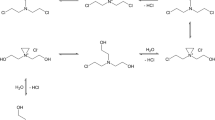Abstract.
The aim was to assess the permeation of different herbicide emulsion concentrate formulations of 2,4-dichlorophenoxyacetic acid (2,4-D) as 60.8 and 83.5% butoxyethyl ester (BEE) and 46.8% dimethyl amine salt (DMAS) through four types of glove materials (lined unsupported nitrile, unlined unsupported butyl, Silver Shield laminate, and Viton). This entailed the development of new microchemical techniques to allow sensitive capillary gas chromatography/mass spectrometry (GC/MS) of the permeated herbicide. The 2,4-D DMAS was esterified to the methyl ester by boron trifluoride-methanol complex with 99.2 ± 3.7% efficiency using microwave heating to minimize reaction time and to process microsamples. The GC/MS detection limit was 5 ng/ml (ppb) of 2,4-D DMAS in the collection medium. The permeates from the ester formulations were analyzed directly for the ester above the detection limit of 9 ng/ml (ppb) BEE. The permeation investigations utilized the American Society for Testing Materials (ASTM)-type permeation cells with liquid collection media. The results showed that these gloves could provide at least 6 h protection for these formulations.
Similar content being viewed by others
Author information
Authors and Affiliations
Additional information
Received: 8 July 1998/Accepted: 13 December 1998
Rights and permissions
About this article
Cite this article
Lin, YW., Que Hee, S. Glove Permeation Tests Using Novel Microchemical Techniques for 2,4-Dichlorophenoxyacetic Acid (2,4-D) Derivatives. Arch. Environ. Contam. Toxicol. 36, 485–489 (1999). https://doi.org/10.1007/PL00006621
Issue Date:
DOI: https://doi.org/10.1007/PL00006621




